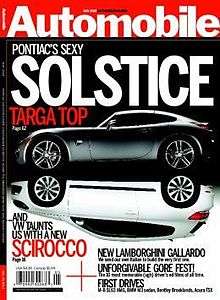DAC (automobile)
The D.A.C. was an automobile manufactured in Detroit, Michigan by the Detroit Air-Cooled Car Company from 1922-23. The car debuted at the Detroit Automobile Show in early 1922, with the company planning on producing 10,000 cars a year. Production never reached these figures. Approximately 25 cars were built in the Detroit factory on Cass Avenue. A new factory was built in 1923, at Wayne, Michigan, where 100 cars were built before the company failed. Both open and closed models were produced. Prices ranged from $1250 for the tourer, to $1700 for the coupe and $1750 for the sedan.
See also
References
External links

Car
A car is a wheeled, self-powered motor vehicle used for transportation and a product of the automotive industry. Most definitions of the term specify that cars are designed to run primarily on roads, to have seating for one to eight people, to typically have four wheels with tyres, and to be constructed principally for the transport of people rather than goods. The year 1886 is regarded as the birth year of the modern car. In that year, German inventor Karl Benz built the Benz Patent-Motorwagen. Cars did not become widely available until the early 20th century. One of the first cars that was accessible to the masses was the 1908 Model T, an American car manufactured by the Ford Motor Company. Cars were rapidly adopted in the United States of America, where they replaced animal-drawn carriages and carts, but took much longer to be accepted in Western Europe and other parts of the world.
Cars are equipped with controls used for driving, parking, passenger comfort and safety, and controlling a variety of lights. Over the decades, additional features and controls have been added to vehicles, making them progressively more complex. Examples include rear reversing cameras, air conditioning, navigation systems, and in car entertainment. Most cars in use in the 2010s are propelled by an internal combustion engine, fueled by deflagration of gasoline (also known as petrol) or diesel. Both fuels cause air pollution and are also blamed for contributing to climate change and global warming. Vehicles using alternative fuels such as ethanol flexible-fuel vehicles and natural gas vehicles are also gaining popularity in some countries. Electric cars, which were invented early in the history of the car, began to become commercially available in 2008.

Automobile (magazine)
Automobile is a United States-based automobile magazine published by TEN: The Enthusiast Network. A group of former employees of Car and Driver led by David E. Davis founded Automobile in 1986 with support from Rupert Murdoch's News Corporation– using the credo No Boring Cars.Automobile distinguishes itself as more of a lifestyle magazine than the other automotive publications, an editorial theme that Davis greatly expanded upon from his tenure as the editor of Car and Driver.
Unlike most other automobile magazines, Automobile does not often do instrumented tests of cars or provide much technical data. Instead, the reviews of vehicles are subjective experiential reports with the cars in their naturally intended, real world environment. Additionally, Automobile reserves a good portion of each issue covering vehicles no longer in production, but still relevant to collectors or automotive history as a whole. For example, the magazine includes features such as "Collectable Classic," an in-depth review of a particular older car, and reports from recent classic and antique car auctions. Automobile also has a regular column by former General Motors designer Robert Cumberford, who analyzes styling elements of current production models and show cars, often linking their design to those of older cars.
Automobile (disambiguation)
An automobile or car is a kind of wheeled motor vehicle. Automobile may also refer to:
DAC
DAC may refer to:
Culture
Politics
Sports
Technology

DAC (vehicle manufacturer)
DAC, short for Diesel Auto Camion, is a Romanian truck brand produced since the 1970s in the Braşov area. Since 1990, DAC has been the special trucks division of Roman trucks.
DAC was established after World War II on the foundation of the old ROMLOC automotive factory built in 1921. In the spirit of the communist days, the industrial plant was named Steagul Rosu (the Red Flag). As of 2000 almost 750,000 trucks had been produced.
DAC trucks share the same construction platforms with the Roman trucks but it was not part of the 1971 venture between the then-West German company MAN and the Romanian government.
CN Series
The CN series was an in house development of AD Basov available since 1977. The CN is available with 4x4, 6x6 and 8x8 wheel configurations and 3 to 10 ton cargo capacity. The CN Series feature a rectangular shaped all-metal cab with horizontally grooved doors and side panels, flat front end and a sloping hinged windshield. Vehicles are equipped with license built MAN D2156 6-cylinder diesel engines and a 5- or 6 -speed transmission, 2-speed transfercase, wheel planetary gear drives, wheels with lockable differentials, dual airbrakes, power steering and a 24-volt electrical devices.
7+3 (chemotherapy)
"7+3" in the context of chemotherapy is an acronym for a chemotherapy regimen that is most often used today (as of 2014) as first-line induction therapy (to induce remission) in acute myelogenous leukemia, excluding the acute promyelocytic leukemia form, which is better treated with ATRA and/or arsenic trioxide and requires less chemotherapy (if requires it at all, which is not always the case).
The name "7+3" comes from the duration of chemotherapy course, which consists of 7 days of standard-dose cytarabine, and 3 days of an antracycline antibiotic or an anthracenedione, most often daunorubicin (can be substituted for doxorubicin or idarubicin or mitoxantrone).
Dosing regimen
Standard-dose cytarabine plus daunorubicin (DA or DAC chemotherapy)
Standard-dose cytarabine plus idarubicin (IA or IAC chemotherapy)
Standard-dose cytarabine plus mitoxantrone (MA or MAC chemotherapy)
Intensified versions
There were attempts to intensify the "7+3" regimen in order to try to improve its efficacy. Attempts were made to prolong the course (cytarabine for 10 days instead of 7, or daunorubicin/idarubicin for 4–5 days instead of 3).

